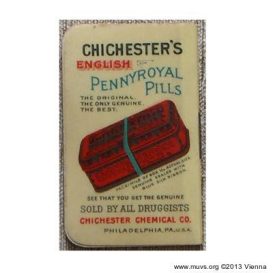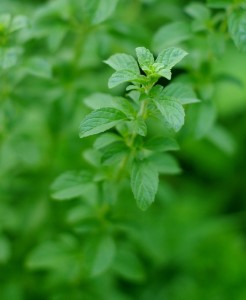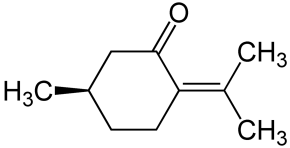*** If you found your way to this page looking for some “help”, especially in light of current events, please, please, please DO NOT use pennyroyal. It can kill you. There are no safe or effective “natural” or “herbal” ways to induce what you may be looking for. ***
Regular readers know of my healthy fear of Mother Nature, and with a background in chemistry leading to a career in itty-bitty-Pharma and now forensic toxicology, many mistakenly believe that I am anti-natural drugs and just a shill for Big Pharma. That thought is pretty far from the truth, and I have yet to see any shill bucks. I’m really not a fan of any drugs, whether they are made in a giant production facility for Big Pharma, the tiny cells of a plant, or in Walter White’s RV, but I recognize the importance and history of natural products. The earliest peoples were naturopaths and used what was around them, from both plant and animal sources, for medicinal purposes. Some of our earliest commercial drugs, of great importance even today, are natural products, like morphine and digitoxin, or semi-synthetic derivatives, like aspirin from salicin. So if someone says chewing willow tree bark works for them, who am I to disagree. Aromatherapy? Why not, I can see how smells could lift a person’s mood and alleviate anxiety or reduce pain. Homeopathy? Water is good for you, stay hydrated . . . I’ll leave it at that.
Where people run into trouble is thinking that natural equals safe and in using products in ways other than intended. The latter is where pennyroyal, Mentha pulegium, fits in. Pennyroyal, a flowering plant native to Europe, is a member of the Lamiaceae family, which contains many aromatic herbs such as mint, basil, oregano, and thyme. [Note: There is also a lesser-known “American Pennyroyal,” Hedeoma pulegioides, with the same properties as its European Pennyroyal relative.] Like its cousins, pennyroyal can be used as a culinary herb and was common throughout the Middle Ages, but in a bit of foreshadowing its use has fallen out of favor in modern times.
Today, the most common preparation of pennyroyal is as its essential oil, extracted from the fresh or dried herb by steam distillation. There are a plethora of purported uses for pennyroyal oil, mostly in aromatherapy by aerial diffusion or topically, most with little to no scientific or medical basis: as an antipsychotic, a digestive aid, a decongestant, for gout, and for hyperhidrosis (excessive sweating) to name a few. Does it work? Probably not, but seeing how horrible a drug colchicine can be, I understand why those afflicted with gout might give pennyroyal a whirl.

Pennyroyal Pills via http://www.muvs.org
Where pennyroyal has seen the most use, however, is an emmenagogue – to stimulate menstruation – and as an abortifacient – to induce the abortion of a fetus. Women taking control of their reproductive systems, via pennyroyal, dates back at least to the early Greeks and was common well into the 20th century. In the early 1900’s pennyroyal pills, in attempts to slip through the prying eyes of anti-abortionists, were sometimes labeled as ‘Elamef’ (read it backward) or simply sold for ‘female troubles.’ But whenever, and however, pennyroyal was used, the thought is that it stimulates the menstrual process and uterine contractions, expelling the fetus and placenta. But like for other indications, there is no documentation that pennyroyal induces abortions. What is well known, however, is its toxicity. (1)
Essential oils can contain various chemicals called terpenes, with menthol and thujone being notable examples (especially if you’ve been reading this site for a while), and pennyroyal oil is no exception. Of the terpenes found, the most prominent is (R)-(+)-pulegone, comprising ~85% of pennyroyal oil. While innocuous-looking, pulegone is largely responsible for pennyroyal’s toxic effects. Phase I metabolism of pugelone (via cytochrome P450 enzymes in the liver) into oxidative metabolites are hepatotoxic, causing liver damage (2, a nice review). A primary metabolite, menthofuran, is also toxic, and is further metabolized into hepatotoxic species. Compounding all of this is the formation of reactive metabolites that deplete hepatic glutathione concentrations. What’s glutathione?* Only one of our body’s most important antioxidants, protecting our liver from drugs, chemicals, and their metabolites. In poisoning cases, the administration of acetylcysteine, a biological precursor of glutathione, is appropriate, much in the same way it is used to treat acetaminophen overdoses (paracetamol, for my UK friends) and remove the toxic N-acetyl-p-benzoquinone imine (NAPQI) metabolite.
*Note to self: make a Nature’s Poison’s Glossary.
Reported deaths – all that I’m aware of are the result of intentional ingestion to induce abortion – are due to liver or multi-organ failure. Symptoms in fatal cases, such as abdominal pain, nausea, and vomiting, present within a few hours of ingesting between 10-30 mL of pennyroyal oil – that’s 2 teaspoons to 2 tablespoons for you home chefs out there (3).
The earliest reported pennyroyal fatality (that I could find) took place in 1897 after a 23-year-old woman drank one tablespoon of pennyroyal oil to induce menstruation, which went missing six months prior (4). She vomited for four days, which abated with morphine and rectal alimentation (that’s ‘eating through your butt’, which was a thing in the good ol’ 1800s). She continued to decline, however, despite the butt feeding and died on the fourth day. An autopsy showed congestion of all internal organs, with a note that the uterus was normal in size, so perhaps she wasn’t pregnant after all.
Fast-forward nearly 100 years to November 1978 . . . During a four-day period at Denver General Hospital, ED physicians saw two pennyroyal cases (5). The first, an 18-year-old female, presented with abdominal pain and vomiting after intentionally ingesting two one-half-ounce bottles of pennyroyal oil to abort a suspected pregnancy (her pregnancy test at the hospital was negative). The only remarkable finding at the time was metabolic acidosis with an anion gap of 25 mEq/L, but her liver enzymes continued to elevate with commensurate renal failure, and she died 7 days after ingestion. The second patient, a 22-year-old female, ingested 10 mL of pennyroyal oil to induce abortion (her pregnancy test was positive). She presented to the ED with dizziness, and clinical labs were all normal. She was discharged after a two-day observation without further problems and was still pregnant.
Is there a problem with pennyroyal, Mentha pulegium? Probably not. I’d eat a few leaves and live to tell the tale just fine. Pennyroyal tea? I’d have a sip. But concentrated oil? Count me out. Pennyroyal is just another example of something that is just fine “as is” when used for culinary or other innocent purposes, but becomes dangerous when concentrated. The last burning question is “does pennyroyal oil induce abortions?” My educated guess is no, at least not without killing the mother in the process. There’s a lot of talk about it throughout the ages, but it’s not the type of things people document, so I suspect we will never know for sure. But until we do, I’ll leave you with Nirvana’s “Pennyroyal Tea.”
*** Homepage featured image of Pennyroyal by born1945 (CC BY 2.0) ***
For a bit about pennyroyal in the garden, see Emma Cooper’s recent post – we didn’t plan it!
References:
1. Gunby, P. “Plant Known for Centuries Still Causes Problems Today.” JAMA: The Journal of the American Medical Association 241.21 (1979): 2246-247.
2. Gordon, Perry, and S. Cyrus Khojasteh. “A Decades-long Investigation of Acute Metabolism-based Hepatotoxicity by Herbal Constituents: A Case Study of Pennyroyal Oil.” Drug Metabolism Reviews 47.1 (2015): 12-20.
3. Anderson, Ilene B. “Pennyroyal Toxicity: Measurement of Toxic Metabolite Levels in Two Cases and Review of the Literature.” Annals of Internal Medicine Ann Intern Med 124.8 (1996): 726.
4. Allen, W.t. “Note On A Case Of Supposed Poisoning By Pennyroyal.” The Lancet 149.3841 (1897): 1022-023.
5. Sullivan, John B. “Pennyroyal Oil Poisoning and Hepatotoxicity.” JAMA JAMA: The Journal of the American Medical Association 242.26 (1979): 2873.


pennyroyal is quite bad but tastes nice – and I would not recommend ingesting any of it: there was a case of a young woman who was drinking pennyroyal tea, which was mislabeled as spearmint tea. It was sold by some health supplement company (“100% organic”), that was buying stuff from China, and apparently they got their herbs wrong.
So she was brewing it several times a day, because she liked the taste, and believe it helped to keep her slim, and she also served it to her husband, who fortunately did not care for it. Only after she ended up in hospital with fulminant liver failure the cause of her miscarriages became clear.
drinking or eating almost any herb while pregnant is not a good idea unless you really know what you’re doing.. But yeah, pennyroyal is also called mosquito plant – it’s an insect repellent.
Oil of Pennyroyal was a common ingredient in the “Fly Dope” insect repellents used in the early 1900s. The most well known formula was from Nessmuk:
3 oz pine tar
2 oz Castor Oil
1 oz Oil of Pennyroyal.
This formed a tar like varnish on the skin.
From a quick google, some still use pennyroyal as a repellent, but mostly just the oil, without the sticky base.
My boss is an herbalist and trained in Traditional Chinese Medicine. TCM never uses single herbs, always using herbs in combination. Mentha pulegium would be a low dose herb (1% or less of a formula), and even so he usually recommends to practitioners (who are trained in herbalism) that they try other herb combos (usually some combo of Artemisioids) in formulas before they utilize Mentha pulegium. He follows up this recommendation with a story (first person account, I believe) in which someone put an ounce of pennyroyal oil into a large hottub and “all the women hemorrhaged.”
Apparently someone once refused to sell my mother pennyroyal, presumable because of the supposed abortifacient qualities. She wanted it to keep fleas out of the apartment.
i want that tea please im in namibia
I agree that you should know your herbs before indiscriminately taking them. But all Rx drugs are not just plants – you can’t sell nature. They add stuff to it to make it a drug they can sell – and they all have a petroleum base – Rockefeller & Carnegie made sure of that.
Pingback: MINI SERIES: Part 2- Emmenagogue Herbs & Pennyroyal Toxicity Cases – The Nephilim Rising™
Pingback: Women’s Fight for Sexual & Reproductive Health Rights – Points: short & insightful writing about the long & complex history of drugs & alcohol
A rather huge “why not” for aromatherapy is that aerosolized lipid droplets containing hormonally active compounds filling your lungs is a great way to promote cancer.
My grandfather had some extremely aggressive cancers move from his lungs to the rest of his body, and used aromatherapy a lot.